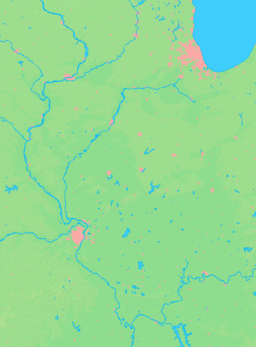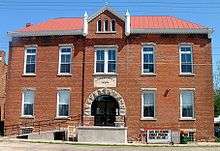Altona, Illinois
| Altona | |
| Village | |
| Country | United States |
|---|---|
| State | Illinois |
| County | Knox |
| Township | Walnut Grove |
| Coordinates | 41°6′48″N 90°9′53″W / 41.11333°N 90.16472°WCoordinates: 41°6′48″N 90°9′53″W / 41.11333°N 90.16472°W |
| Area | 1.00 sq mi (3 km2) |
| - land | 1.00 sq mi (3 km2) |
| - water | 0.00 sq mi (0 km2) |
| Density | 560.8/sq mi (217/km2) |
| Timezone | CST (UTC-6) |
| - summer (DST) | CDT (UTC-5) |
| Postal code | 61414 |
| Area code | 309 |
  Location of Altona within Illinois
| |

Altona (formerly LaPier & Walnut Grove) is a village in Knox County, Illinois, United States. The population was 531 at the 2010 census, down from 570 in 2000.[1] It is part of the Galesburg Micropolitan Statistical Area.
History
Altona was originally called La Pier, and under the latter name was laid out in 1834.[2]
Geography
Altona is located at 41°6′48″N 90°9′53″W / 41.11333°N 90.16472°W (41.113472, -90.164613).[3]
According to the 2010 census, Altona has a total area of 1 square mile (2.59 km2), all land.[4]
Demographics
| Historical population | |||
|---|---|---|---|
| Census | Pop. | %± | |
| 1870 | 902 | — | |
| 1880 | 818 | −9.3% | |
| 1890 | 654 | −20.0% | |
| 1900 | 633 | −3.2% | |
| 1910 | 528 | −16.6% | |
| 1920 | 506 | −4.2% | |
| 1930 | 464 | −8.3% | |
| 1940 | 480 | 3.4% | |
| 1950 | 462 | −3.7% | |
| 1960 | 505 | 9.3% | |
| 1970 | 542 | 7.3% | |
| 1980 | 610 | 12.5% | |
| 1990 | 559 | −8.4% | |
| 2000 | 570 | 2.0% | |
| 2010 | 531 | −6.8% | |
| Est. 2015 | 511 | [5] | −3.8% |
As of the census[7] of 2000, there were 570 people, 216 households, and 160 families residing in the village. The population density was 560.8 people per square mile (215.8/km²). There were 230 housing units at an average density of 226.3 per square mile (87.1/km²). The racial makeup of the village was 99.47% White, 0.18% Asian, 0.35% from other races. Hispanic or Latino of any race were 0.88% of the population.
There were 216 households out of which 32.9% had children under the age of 18 living with them, 62.5% were married couples living together, 7.9% had a female householder with no husband present, and 25.9% were non-families. 22.7% of all households were made up of individuals and 11.6% had someone living alone who was 65 years of age or older. The average household size was 2.64 and the average family size was 3.08.
In the village the population was spread out with 27.0% under the age of 18, 8.8% from 18 to 24, 26.7% from 25 to 44, 24.4% from 45 to 64, and 13.2% who were 65 years of age or older. The median age was 37 years. For every 100 females there were 96.6 males. For every 100 females age 18 and over, there were 101.0 males.
The median income for a household in the village was $35,729, and the median income for a family was $39,318. Males had a median income of $32,813 versus $21,111 for females. The per capita income for the village was $15,805. About 2.9% of families and 6.2% of the population were below the poverty line, including 8.1% of those under age 18 and 4.8% of those age 65 or over.
Education
ROWVA School District #208 is made up of five major towns: Rio, Oneida, Wataga, Victoria, and Altona. PreK-2nd graders go to ROWVA Central in Oneida, 3rd and 4th graders attend ROWVA West in Wataga, and 5th and 6th graders go to ROWVA East in Altona. The junior high is located in Oneida and is made up of 7th and 8th graders. The high school made up of 9th-12th graders and is also located in Oneida. ROWVA Central, ROWVA Jr. High, and ROWVA High School are all in one basic building, just different sections. ROWVA's school colors are black, gold, and white, with their mascot being a tiger. The school is ending a five-year-long football co-op with AlWood at the end of the 2009 football season, in which they are the A&R Bulldogs (black, silver, and white.) Starting in the 2009 fall season, ROWVA is also part of a sports co-op with Galva where they are the Mid-County Cougars (black, blue, and white.) ROWVA is a part of the Mid-County co-op for golf, cross country, junior high football, and will be high school football starting in the 2010 football season.
References
- ↑ City data. 2000 census information Retrieved on May 16, 2007
- ↑ Callary, Edward (29 September 2008). Place Names of Illinois. University of Illinois Press. p. 8. ISBN 978-0-252-09070-7.
- ↑ "US Gazetteer files: 2010, 2000, and 1990". United States Census Bureau. 2011-02-12. Retrieved 2011-04-23.
- ↑ "G001 - Geographic Identifiers - 2010 Census Summary File 1". United States Census Bureau. Retrieved 2015-08-01.
- ↑ "Annual Estimates of the Resident Population for Incorporated Places: April 1, 2010 to July 1, 2015". Retrieved July 2, 2016.
- ↑ "Census of Population and Housing". Census.gov. Archived from the original on May 11, 2015. Retrieved June 4, 2015.
- ↑ "American FactFinder". United States Census Bureau. Archived from the original on 2013-09-11. Retrieved 2008-01-31.